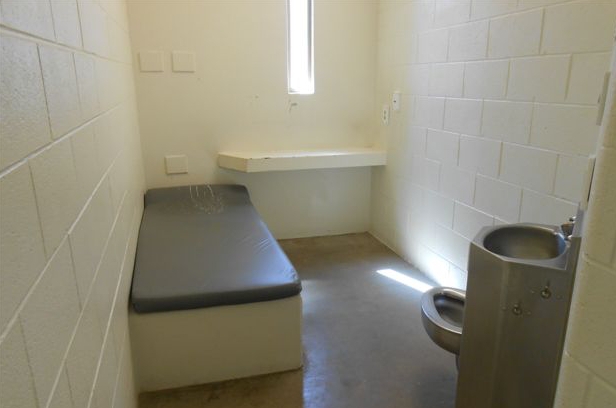Solitary Confinement
Conditions of solitary confinement vary significantly. The term solitary confinement refers to physical isolation of individuals in which they are confined in their cells for around twenty-three hours each day (typically twenty-two to twenty-four hours). The amount of contact with prison staff can vary and may constitute more than an hour each day, but only rarely will this contact be socially and psychologically meaningful. Contact with prison staff typically takes place in connection with being escorted to the exercise yard or the toilet or through brief encounters when meals are delivered to the cell door. Complete and total isolation is not practiced anywhere. In that sense, solitary confinement constitutes individual social isolation (and perhaps perceptual deprivation) rather than sensory deprivation (Volkart, Dittrich, et al. 1983, p. 27).
Links to additional relevant NGOs
- https://www.aclu.org/issues/prisoners-rights/solitary-confinement
- http://www.nrcat.org/index.php?option=com_content&view=article&id=546&Itemid=396
- http://www.stopsolitaryforkids.org/
- http://www.centerforhumanrights.org/Prisoners.html
Sources to Consult
- https://www.aclu.org/podcast/prison-voices-billy-mccarthy-we-are-augustines-talks-about-solitary-confinement-and-mental?redirect=prisoners-rights/prison-voices-billy-mccarthy-we-are-augustines-talks-about-solitary-confinement-and
- http://www.centerforhumanrights.org/Prisoners.html
- https://www.youtube.com/watch?v=1-MitPpX1vY
- https://www.aclu.org/infographic/joe-giarratano-stories-solitary?redirect=prisoners-rights/joe-giarratano
- https://vimeo.com/78840078
- http://www.jstor.org/stable/10.1086/500626
- http://www.jstor.org/stable/10.5323/jafriamerhist.98.2.0197
- http://www.telegraph.co.uk/news/worldnews/northamerica/usa/10968713/Solitary-confinement-inside-Americas-dreaded-isolation-cells.html
Works Cited “Billy McCarthy of We Are Augustines Talks About Solitary Confinement and Mental Illness.” Prison Voices from ACLU, https://www.aclu.org/podcast/prison-voices-billy-mccarthy-we-are-augustines-talks-about-solitary-confinement-and-mental?redirect=prisoners-rights/prison-voices-billy-mccarthy-we-are-augustines-talks-about-solitary-confinement-and. In a podcast interview, Billy McCarthy discusses his brother’s struggle with mental illness and the turning points in James’ life. Billy argues that solitary confinement is inhumane, and patients’ mental illnesses are rarely taken into account when their surrounding environment undoubtedly worsens their mental condition. “California Prisoners in Solitary Confinement.” Center for Human Rights and Constitutional Law. Center for Human Rights and Constitutional Law, n.d. Web. . The Center for Human Rights and Constitutional Law is a non-profit, public interest legal foundation dedicated to furthering and protecting the civil, constitutional, and human rights of immigrants, refugees, children, prisoners, and the poor” and advocates for prisoners in California in solitary confinement. The website provides comprehensive information on solitary confinement regarding statistics, petitions individuals can sign to end solitary confinement, information of the psychological effects of confinement, testimonials from inmates, and access to other organizations advocating against solitary. This website is beneficial for any individual, primarily from California, to visit in order to combat solitary confinement. Casella, Jean, James Ridgeway, and Sarah Shourd, eds. Hell is a Very Small Place. New York: The New Press, 2016. Print. In this compilation of essays from inmates, the effects of solitary confinement on these individuals is highlighted. 16 inmates in solitary confinement share excerpts from essays they wrote on enduring, resisting, and surviving life in solitary. Some common themes seen in the book include: misery, loneliness, insanity, rape, depression, sex abuse, and anger. The book also contains perspectives on solitary confinement from various experts in the field. Fettig, Amy, Anthony Graves, Emily Tucker, and Laura Markle. “Solitary Confinement in an Age of Mass Incarceration.” 18 Apr. 2013. Web. . In this webinar by the National Religious Campaign Against Torture leading policy experts present “an overview of legislative efforts to end prolonged solitary confinement, including stories of surviving solitary confinement”. Anthony Graves, one of the contributors, gives his testimony on what life in solitary confinement was like after he spent 16 years in solitary before his conviction was overturned. “Joe Giarratano – Stories from Solitary.” ACLU, https://www.aclu.org/infographic/joe-giarratano-stories-solitary?redirect=prisoners-rights/joe-giarratano. Accessed 29 March 2017. In a letter, Joe Giarratano discusses his 8 years in solitary confinement. He recalls 80-day hunger strikes, vitamin D deficiencies, and the disturbing noises that haunted him from other cells. Giarratano concludes his letter by declaring, “I do not care how strong one is mentally solitary confinement will adversely affect you. I have literally watched grown men deteriorate before my eyes, and go mad.” He believes solitary confinement should only be a last resort, and that the stints should be no longer than “1 – 3 days tops.” “Out of Sight, Out of Mind – The Story of Sam Mandez.” Vimeo uploaded by ACLU of Colorado, 7 November 2013, https://vimeo.com/78840078. Sam Mandez has been in solitary confinement since 1997. He was one of 75 prisoners (2013) in Colorado’s prisons who suffers from severe mental illness. The short film is a compilation of testimonies describing solitary confinement and it’s impact on the mental health of prisoners. Pizarro, J. M., and R. E. Narag. “Supermax Prisons: What We Know, What We Do Not Know, and Where We Are Going.” The Prison Journal88.1 (2008): 23-42. Web. Jesenia M. Pizarro and Raymund E. Narag explore what the academic community knows about supermax prisons (prisons where all prisoners are in solitary confinement), how courts have ruled in U.S. supermax prison litigations and if current cases and research might indicate trends into the future of supermax prisons. Smith, Peter Scharff. “The Effects of Solitary Confinement on Prison Inmates: A Brief History and Review of the Literature.” Crime and Justice, vol. 34, no. 1, 2006, pp. 441–528., www.jstor.org/stable/10.1086/500626. In this article, Peter Scharff Smith discusses solitary confinement in history. According to the abstract: “ The weight of the modern evidence concurs with the findings of earlier research: whether and how isolation damages people depends on duration and circumstances and is mediated by prisoners’ individual characteristics; but for many prisoners, the adverse effects are substantial.” Solitary Watch. Ed. James Ridgeway and Jean Casella. Solitary Watch, n.d. Web. Solitary Watch “is a watchdog project that investigates, documents, and disseminates information on the widespread use of solitary confinement out of the shadows and into the light of the public square”. The website provides an extensive amount of resources regarding solitary confinement including: statistics, advocacy group information, publications, and testimonials. This website is beneficial for any individual who is interested in learning about all aspects of solitary confinement in the United States. “Stories of Life in Solitary Confinement – Short Film Showcase.” Youtube, uploaded by National Geographic, 6 August 2016, https://www.youtube.com/watch?v=Q7ajzsh-i54. The short film includes testimonies by inmates at Pelican Bay State Prison’s Security Housing Unit V. P. Franklin. “COMMENTARY—SOLITARY CONFINEMENT: ‘I FEEL LIKE … NO ONE CARES ABOUT ME.’” The Journal of African American History, vol. 98, no. 2, 2013, pp. 197–198., www.jstor.org/stable/10.5323/jafriamerhist.98.2.0197. V. P. Franklin discusses the demographics of those in solitary confinement. He emphasizes the majority of people of color in this system and poses questions regarding the reason for incarceration of minors as well as the possibilities for change in the system that could better the circumstances plaguing the prison system. Vera, Helen. “The Most Terrifying Thing In ‘Orange Is The New Black’ Happens In Real Life.” Business Insider. Business Insider, 20 June 2014. Web. 28 Mar. 2017. Helen Vera discusses how solitary confinement is portrayed in Orange is the New Black, the Netflix Original Series where solitary confinement is a dark looming cloud over the prisoners heads. Walters, Joanna. “Solitary confinement: Inside America’s dreaded isolation cells.” The Telegraph, 16 July 2014, http://www.telegraph.co.uk/news/worldnews/northamerica/usa/10968713/Solitary-confinement-inside-Americas-dreaded-isolation-cells.html.
Testimonials
Anthony Graves – American Civil Liberties Union ( https://www.aclu.org/blog/when-i-was-death-row-i-saw-bunch-dead-men-walking-solitary-confinement-killed-everything-inside?redirect=blog/prisoners-rights-capital-punishment/when-i-was-death-row-i-saw-bunch-dead-men-walking-solitary) Joe Giarratano – American Civil Liberties Union (https://www.aclu.org/infographic/joe-giarratano-stories-solitary?redirect=prisoners-rights/joe-giarratano) Judith Vazquez – “Hell is a Very Small Place” (Casella, Jean, James Ridgeway, and Sarah Shourd, eds. Hell is a Very Small Place. New York: The New Press, 2016. Print.) Ricky Silva – Solitary Watch (http://solitarywatch.com/2014/07/24/voices-solitary-3/) Sarah Shourd – American Civil Liberties Union (https://www.aclu.org/blog/speakeasy/iranian-government-locked-me-solitary-confinement-410-days-today-my-thoughts-are?redirect=blog/prisoners-rights/iranian-government-locked-me-solitary-confinement-410-days-today-my-thoughts) Sam Mandez – ACLU of Colorado via Vimeo (https://vimeo.com/78840078) Shane Bauer – Mother Jones Media (http://www.motherjones.com/politics/2012/10/solitary-confinement-shane-bauer) William Blake – “Hell is a Very Small Place” (Casella, Jean, James Ridgeway, and Sarah Shourd, eds. Hell is a Very Small Place. New York: The New Press, 2016. Print.)

